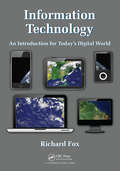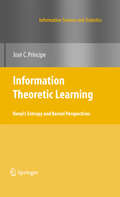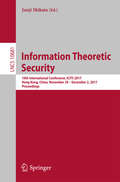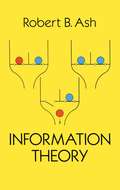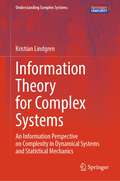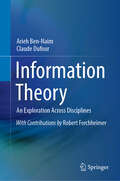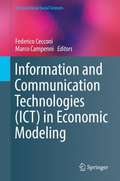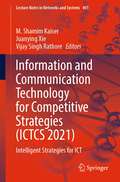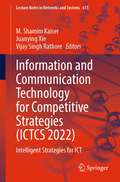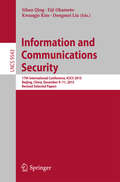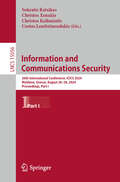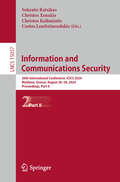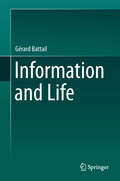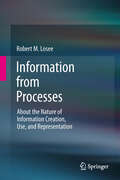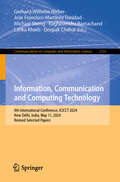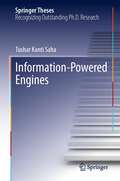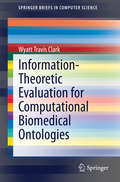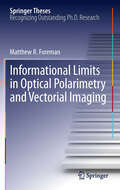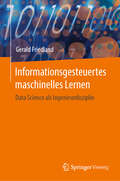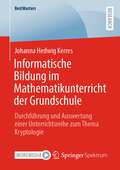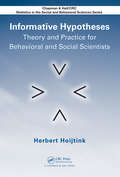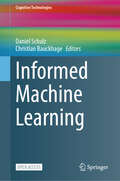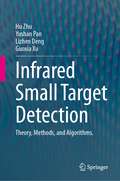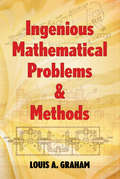- Table View
- List View
Information Technology: An Introduction for Today's Digital World
by Richard FoxInformation Technology: An Introduction for Today's Digital World introduces undergraduate students to a wide variety of concepts they will encounter throughout their IT studies and careers. The book covers computer organization and hardware, Windows and Linux operating systems, system administration duties, scripting, computer networks, regular ex
Information Theoretic Learning
by Jose C. PrincipeThis book presents the first cohesive treatment of Information Theoretic Learning (ITL) algorithms to adapt linear or nonlinear learning machines both in supervised or unsupervised paradigms. ITL is a framework where the conventional concepts of second order statistics (covariance, L2 distances, correlation functions) are substituted by scalars and functions with information theoretic underpinnings, respectively entropy, mutual information and correntropy. ITL quantifies the stochastic structure of the data beyond second order statistics for improved performance without using full-blown Bayesian approaches that require a much larger computational cost. This is possible because of a non-parametric estimator of Renyi's quadratic entropy that is only a function of pairwise differences between samples. The book compares the performance of ITL algorithms with the second order counterparts in many engineering and machine learning applications. Students, practitioners and researchers interested in statistical signal processing, computational intelligence, and machine learning will find in this book the theory to understand the basics, the algorithms to implement applications, and exciting but still unexplored leads that will provide fertile ground for future research.
Information Theoretic Security: 10th International Conference, ICITS 2017, Hong Kong, China, November 29 – December 2, 2017, Proceedings (Lecture Notes in Computer Science #10681)
by Junji ShikataThis book constitutes the refereed proceedings of the 10th International Conference on Information Theoretic Security, ICITS 2017, held in Hong Kong, China, in November/December 2017.The 12 full papers were carefully reviewed and selected from 42 submissions. They are organized around the following topics: quantum cryptography; quantum information theory; post-quantum cryptography (e.g. lattices and cryptography); physical layer security; wiretap channels; adversarial channel models; cryptography from noisy channels; bounded storage models; network coding security; biometric security; randomness extraction; key and message rates; secret sharing; authentication codes; multiparty computations; information theoretic reductions; and implementation challenges.
Information Theory
by Robert B. AshExcellent introduction treats 3 major areas: analysis of channel models and proof of coding theorems; study of specific coding systems; and study of statistical properties of information sources. Appendix summarizes Hilbert space background and results from the theory of stochastic processes. Advanced undergraduate to graduate level. Bibliography.
Information Theory and Statistics
by Solomon KullbackHighly useful text studies logarithmic measures of information and their application to testing statistical hypotheses. Includes numerous worked examples and problems. References. Glossary. Appendix. 1968 2nd, revised edition.
Information Theory for Complex Systems: An Information Perspective on Complexity in Dynamical Systems and Statistical Mechanics (Understanding Complex Systems)
by Kristian LindgrenThis book introduces a comprehensive framework tailored for dissecting complex systems across diverse disciplines. What defines a complex system? How can we harness information to quantify its order, structure, and intricacy? Delving into phenomena from the intricate processes in physical systems to the dynamic behaviours in cellular automata and pattern formation, readers will uncover the profound interplay between physics and information theory. This intricate relationship provides fresh insight into physical phenomena, reimagining them through the lens of information. Notably, the book demystifies how seemingly opposing forces—rising order and increasing disorder—coexist, ultimately shedding light on the second law of thermodynamics as an outcome of deterministic, reversible dynamics beneath the surface. Geared towards graduate students, this book presumes an undergraduate foundation in mathematics and physics, ensuring a deep, engaging exploration for its readers.
Information Theory: An Exploration Across Disciplines
by Arieh Ben-Naim Claude DufourThis monograph explores the interdisciplinary applications of information theory, focusing on the concepts of entropy, mutual information, and their implications in various fields. It explains the fundamental differences between entropy and Shannon’s Measure of Information (SMI), presents the application of information theory to living systems and psychology, and also discusses the role of entropy in art. It critically overviews the definition of correlations and multivariate mutual information.These notions are used to build a new perspective for understanding the irreversibility of processes in macroscopic systems, while the dynamical laws governing the microscopic components are reversible. It also delves into the use of mutual information in linguistics, cryptography, steganography, and communication systems. The book details the theoretical and practical aspects of information theory across a spectrum of disciplines and is a useful tool for any scientist interested in what is usually called entropy.
Information and Communication Technologies (Computational Social Sciences)
by Federico Cecconi Marco CampennìThis book presents the effects of integrating information and communication technologies (ICT) and economic processes in macroeconomic dynamics, finance, marketing, industrial policies, and in government economic strategy. The text explores modeling and applications in these fields and also describes, in a clear and accessible manner, the theories that guide the integration among information technology (IT), telecommunications, and the economy, while presenting examples of their applications. Current trends such as artificial intelligence, machine learning, and big data technologies used in economics are also included. This volume is suitable for researchers, practitioners, and students working in economic theory and the computational social sciences.
Information and Communication Technology for Competitive Strategies: Intelligent Strategies for ICT (Lecture Notes in Networks and Systems #401)
by Vijay Singh Rathore M. Shamim Kaiser Juanying XieThis book contains best selected research papers presented at ICTCS 2021: Sixth International Conference on Information and Communication Technology for Competitive Strategies. The conference will be held at Jaipur, Rajasthan, India, during December 17–18, 2021. The book covers state-of-the-art as well as emerging topics pertaining to ICT and effective strategies for its implementation for engineering and managerial applications. This book contains papers mainly focused on ICT for computation, algorithms and data analytics, and IT security. The book is presented in two volumes.
Information and Communication Technology for Competitive Strategies: Intelligent Strategies for ICT (Lecture Notes in Networks and Systems #615)
by Vijay Singh Rathore M. Shamim Kaiser Juanying XieThis book contains best selected research papers presented at ICTCS 2022: Seventh International Conference on Information and Communication Technology for Competitive Strategies. The conference will be held in Chandigarh, India, during December 9–10, 2022. The book covers state-of-the-art as well as emerging topics pertaining to ICT and effective strategies for its implementation for engineering and managerial applications. This book contains papers mainly focused on ICT for computation, algorithms and data analytics and IT security. The work is presented in two volumes.
Information and Communications Security
by Sihan Qing Eiji Okamoto Kwangjo Kim Dongmei LiuThis book constitutes the thoroughly refereed post-conference proceedings of the 17th International Conference on Information and Communications Security, ICISC 2015, held in Beijing, China, in December 2015. The 24 revised full papers and 19 short papers presented were carefully selected from 148 submissions. The papers provide the latest results in research and development in the field of information security and applied cryptology.
Information and Communications Security: 26th International Conference, ICICS 2024, Mytilene, Greece, August 26–28, 2024, Proceedings, Part I (Lecture Notes in Computer Science #15056)
by Sokratis Katsikas Costas Lambrinoudakis Christos Kalloniatis Christos XenakisThis two-volume proceedings set LNCS 15056-15057 constitutes the proceedings of 26th International Conference on Information and Communications Security, ICICS 2024, in Mytilene, Greece, during August 26-28, 2024. The 32 full papers presented in this book were carefully selected and reviewed from 123 submissions. They cover topics related to many aspects of security in information and communication systems, ranging from attacks, to defences, to trust issues, to anomaly-based intrusion detection, to privacy preservation, and to theory and applications of various cryptographic techniques.
Information and Communications Security: 26th International Conference, ICICS 2024, Mytilene, Greece, August 26–28, 2024, Proceedings, Part II (Lecture Notes in Computer Science #15057)
by Sokratis Katsikas Costas Lambrinoudakis Christos Kalloniatis Christos XenakisThis two-volume proceedings set LNCS 15056-15057 constitutes the proceedings of 26th International Conference on Information and Communications Security, ICICS 2024, in Mytilene, Greece, during August 26-28, 2024. The 32 full papers presented in this book were carefully selected and reviewed from 123 submissions. They cover topics related to many aspects of security in information and communication systems, ranging from attacks, to defences, to trust issues, to anomaly-based intrusion detection, to privacy preservation, and to theory and applications of various cryptographic techniques.
Information and Life
by Gérard BattailCommunication, one of the most important functions of life, occurs at any spatial scale from the molecular one up to that of populations and ecosystems, and any time scale from that of fast chemical reactions up to that of geological ages. Information theory, a mathematical science of communication initiated by Shannon in 1948, has been very successful in engineering, but biologists ignore it. This book aims at bridging this gap. It proposes an abstract definition of information based on the engineers' experience which makes it usable in life sciences. It expounds information theory and error-correcting codes, its by-products, as simply as possible. Then, the fundamental biological problem of heredity is examined. It is shown that biology does not adequately account for the conservation of genomes during geological ages, which can be understood only if it is assumed that genomes are made resilient to casual errors by proper coding. Moreover, the good conservation of very old parts of genomes, like the HOX genes, implies that the assumed genomic codes have a nested structure which makes an information the more resilient to errors, the older it is. The consequences that information theory draws from these hypotheses meet very basic but yet unexplained biological facts, e.g., the existence of successive generations, that of discrete species and the trend of evolution towards complexity. Being necessarily inscribed on physical media, information appears as a bridge between the abstract and the concrete. Recording, communicating and using information exclusively occur in the living world. Information is thus coextensive with life and delineates the border between the living and the inanimate.
Information from Processes
by Robert M. LoseeInformation is an important concept that is studied extensively across a range of disciplines, from the physical sciences to genetics to psychology to epistemology. Information continues to increase in importance, and the present age has been referred to as the "Information Age." One may understand information in a variety of ways. For some, information is found in facts that were previously unknown. For others, a fact must have some economic value to be considered information. Other people emphasize the movement through a communication channel from one location to another when describing information. In all of these instances, information is the set of characteristics of the output of a process. Yet Information has seldom been studied in a consistent way across different disciplines. Information from Processes provides a discipline-independent and precise presentation of both information and computing processes. Information concepts and phenomena are examined in an effort to understand them, given a hierarchy of information processes, where one process uses others. Research about processes and computing is applied to answer the question of what information can and cannot be produced, and to determine the nature of this information (theoretical information science). The book also presents some of the basic processes that are used in specific domains (applied information science), such as those that generate information in areas like reasoning, the evolution of informative systems, cryptography, knowledge, natural language, and the economic value of information. Written for researchers and graduate students in information science and related fields, Information from Processes details a unique information model independent from other concepts in computer or archival science, which is thus applicable to a wide range of domains. Combining theoretical and empirical methods as well as psychological, mathematical, philosophical, and economic techniques, Losee's book delivers a solid basis and starting point for future discussions and research about the creation and use of information.
Information, Communication and Computing Technology: 9th International Conference, ICICCT 2024, New Delhi, India, May 11, 2024, Revised Selected Papers (Communications in Computer and Information Science #2131)
by Gerhard-Wilhelm Weber Michael Sheng Latika Kharb Deepak Chahal Jose Francisco Martinez Trinidad Raghavendra RamachandThis book constitutes the refereed proceedings of the 9th International Conference on Information, Communication and Computing Technology, ICICCT 2024, held in New Delhi, India, on May 11, 2024. The 13 full papers presented here were carefully reviewed and selected from 176 submissions. These papers have been categorized into the following topical sections: Intelligent systems and Pattern recognition.
Information-Powered Engines (Springer Theses)
by Tushar Kanti SahaThis book presents the experimental development of an information-powered engine inspired by the famous thought experiment, Maxwell’s demon, to understand its potential to produce energy for practical purposes. The development of an engine based on Maxwell’s demon was for a long time inconceivable, but technological advances have led to novel investigations into theoretical and practical applications. The built information engine consists of a micron-sized glass bead trapped in a tightly focused laser beam. It rectifies the bead's Brownian motion by controlling the laser's position and generates a unidirectional motion against gravity without doing any work, thus converting thermal heat into stored gravitational potential energy. A theoretical model based on a spring-mass system describes the engine's dynamics and was then used to find optimum parameters to improve the engine's performance. Experimentally implementing these optimization strategies led to engine output powers comparable to those measured in biological motors. This book also highlights performance improvements made in the presence of measurement noise and presents important guiding principles to design information engines to operate in non-equilibrium environments. By focusing on practical applications, the book overall aims to broaden the scope of information-engine investigations.
Information-Theoretic Evaluation for Computational Biomedical Ontologies
by Wyatt Travis ClarkThe development of effective methods for the prediction of ontological annotations is an important goal in computational biology, yet evaluating their performance is difficult due to problems caused by the structure of biomedical ontologies and incomplete annotations of genes. This work proposes an information-theoretic framework to evaluate the performance of computational protein function prediction. A Bayesian network is used, structured according to the underlying ontology, to model the prior probability of a protein's function. The concepts of misinformation and remaining uncertainty are then defined, that can be seen as analogs of precision and recall. Finally, semantic distance is proposed as a single statistic for ranking classification models. The approach is evaluated by analyzing three protein function predictors of gene ontology terms. The work addresses several weaknesses of current metrics, and provides valuable insights into the performance of protein function prediction tools.
Informational Limits in Optical Polarimetry and Vectorial Imaging
by Matthew R. ForemanCentral to this thesis is the characterisation and exploitation of electromagnetic properties of light in imaging and measurement systems. To this end an information theoretic approach is used to formulate a hitherto lacking, quantitative definition of polarisation resolution, and to establish fundamental precision limits in electromagnetic systems. Furthermore rigorous modelling tools are developed for propagation of arbitrary electromagnetic fields, including for example stochastic fields exhibiting properties such as partial polarisation, through high numerical aperture optics. Finally these ideas are applied to the development, characterisation and optimisation of a number of topical optical systems: polarisation imaging; multiplexed optical data storage; and single molecule measurements. The work has implications for all optical imaging systems where polarisation of light is of concern.
Informationsgesteuertes maschinelles Lernen: Data Science als Ingenieurdisziplin
by Gerald FriedlandDieses innovative Lehrbuch revolutioniert das maschinelle Lernen durch neue Informationsmessungsmethoden. Es basiert auf einem Seminar der UC Berkeley und zielt darauf ab, die Black-Box-Natur des maschinellen Lernens zu überwinden, indem es Datenqualitätsmessungen und A-priori-Schätzungen der Aufgabenkomplexität ermöglicht. Dies führt zu kleineren, erklärbareren und robusteren Modellen.Das Lehrbuch verbindet maschinelles Lernen mit Physik, Informationstheorie und Computertechnik und ist für ein breites Publikum verständlich. Es hinterfragt bestehende Branchenpraktiken und behandelt Themen wie Deep Learning und Datendrift. Geeignet für Akademiker und Industrieprofis, fördert es ein tiefgreifendes Verständnis von Data Science und lädt Leser ein, über konventionelle Ansätze hinauszudenken. Anstatt sich ausschließlich auf das „Wie“ zu konzentrieren, bietet dieser Text Antworten auf die „Warum“-Fragen, die das Fachgebiet durchdringen, und beleuchtet die zugrunde liegenden Prinzipien maschineller Lernprozesse und ihre praktischen Auswirkungen. Indem dieses Buch systematische Methoden bevorzugt, die auf physikalischen Grundprinzipien basieren, stellt es Branchenpraktiken in Frage, die oft aus ideologischen oder gewinnorientierten Motivationen entstanden sind. Es behandelt eine Reihe von Themen, darunter Deep Learning, Datendrift und MLOps, und nutzt ausgiebig grundlegende Konzepte wie Entropie, Kapazität und hohe Dimensionalität.Dieses Buch ist sowohl für Hochschul- als auch für Industrieprofis geeignet und dient als wertvolles Werkzeug für diejenigen, die ihr Verständnis von Data Science als Ingenieurdisziplin vertiefen möchten. Der zum Nachdenken anregende Inhalt regt die intellektuelle Neugier an und richtet sich an Leser, die mehr wollen als nur Code oder vorgefertigte Formeln. Der Text lädt die Leser dazu ein, über konventionelle Standpunkte hinauszuforschen und bietet eine alternative Perspektive, die eine umfassende Sichtweise für die Integration von Theorie und Praxis fördert. Dieses Buch eignet sich für Kurse im Grund- und Hauptstudium und kann auch praktizierenden Ingenieuren und Wissenschaftlern verschiedener Disziplinen zugute kommen, indem es ihr Verständnis der Modellierung vertieft und die Datenmessung effektiv verbessert.
Informatische Bildung im Mathematikunterricht der Grundschule: Durchführung und Auswertung einer Unterrichtsreihe zum Thema Kryptologie (BestMasters)
by Johanna Hedwig KerresInformatische Bildung in der Grundschule wird durch die von Medien und Informatiksystemen durchzogene Welt relevant. Im Kontrast dazu bindet der Lehrplan NRW für den Mathematikunterricht an Grundschulen diesen Bereich nicht ein. Ziel des Bandes ist der Ausbau des Forschungsstandes zum Thema informatische Bildung in der Grundschule, um einerseits die Relevanz auszuarbeiten und andererseits das Themenfeld didaktisch zu legitimieren. Dazu wurde im Sinne der fachdidaktischen Entwicklungsforschung eine Unterrichtsreihe zum Themenfeld Kryptologie durchgeführt. Durch Standortbestimmungen und Interviews wurde die Kompetenzentwicklung der Schüler*innen im Verlauf gemessen und ausgewertet. Aus den Ergebnissen ergibt sich der Bedarf der Einbindung informatischer Bildung in den Bildungskanon der Grundschule.
Informative Hypotheses: Theory and Practice for Behavioral and Social Scientists
by Herbert HoijtinkWhen scientists formulate their theories, expectations, and hypotheses, they often use statements like: ``I expect mean A to be bigger than means B and C"; ``I expect that the relation between Y and both X1 and X2 is positive"; and ``I expect the relation between Y and X1 to be stronger than the relation between Y and X2". Stated otherwise, they fo
Informed Machine Learning (Cognitive Technologies)
by Daniel Schulz Christian BauckhageThis open access book presents the concept of Informed Machine Learning and demonstrates its practical use with a compelling collection of applications of this paradigm in industrial and business use cases. These range from health care over manufacturing and material science to more advanced combinations with deep learning, say, in the form of physical informed neural networks. The book is intended for those interested in modern informed machine learning for a wide range of practical applications where the aspect of small data sets is a challenge. Machine Learning with small amounts of data? After the recent success of Artificial Intelligence based on training with massive amounts of data, this idea may sound exotic. However, it addresses crucial needs of practitioners in industry. While many industrial applications stand to benefit from the use of AI, the amounts of data needed by current learning paradigms are often hard to come by in industrial settings. As an alternative, learning methods and models are called for which integrate other sources of knowledge in order to compensate for the lack of data. This is where the principle of “Informed Machine Learning” comes into play. Informed Machine Learning combines purely data driven learning and knowledge-based techniques to learn from both data and knowledge. This has several advantages. It reduces the need for data, it often results in smaller, less complex and more robust models, and even makes machine learning applicable in settings where data is scarce. The kind of knowledge to be incorporated into learning processes can take many different forms, for example, differential equations, analytical models, simulation results, logical rules, knowledge graphs, or human feedback which makes the approach overall very powerful and widely applicable.
Infrared Small Target Detection: Theory, Methods, and Algorithms.
by Hu Zhu Yushan Pan Lizhen Deng Guoxia XuUncover the secrets of cutting-edge research in “Infrared Small Target Detection,” a crucial resource that delves into the dynamic world of infrared imaging and detection algorithms. This comprehensive book is an indispensable gem for the research community, offering a profound introduction to the theory, methods, and algorithms underlying infrared small object detection. As an invaluable guide, this book explores diverse models and categories of infrared small object detection algorithms, providing meticulous descriptions and comparisons of their strengths and limitations. Perfectly tailored for researchers, practitioners, and students with a passion for infrared imaging and detection, this book equips readers with the necessary knowledge to embark on groundbreaking investigations in this field.Readers can particularly be drawn to the book's methods, results, and topics, encompassing diverse categories of infrared small object detection algorithms and their corresponding advantages and disadvantages. The book also imparts foundational knowledge in mathematical morphology, tensor decomposition, and deep learning, enabling readers to grasp the underlying principles of these advanced algorithms. Experience the key benefits of “Infrared Small Target Detection” as readers gain a profound understanding of theory, methods, and algorithms tailored to infrared small object detection. The comprehensive descriptions and comparisons of various algorithm categories empower readers to select the perfect algorithms for their specific applications. Unlock the potential of this groundbreaking resource with a basic understanding of mathematics, statistics, and image processing. Some familiarity with infrared imaging and detection proves advantageous in fully immersing oneself in the wealth of knowledge presented within these pages.
Ingenious Mathematical Problems and Methods
by Louis A. GrahamFor two decades, an international readership of workers in applied mathematics submitted their favorite puzzles to a mid-twentieth-century column, The Graham Dial. This original collection features 100 of the publication's very best problems, with themes ranging from logic and engineering situations to number theory and geometry. Each problem was specifically selected for its widely differing modes of solution, and most include several methods of solution plus assessments of their efficacy.In checking their solutions against the book's, readers may find that their interest in the puzzles increases. The search for an answer can develop into a challenge to improve upon existing solutions, as in a friendly competition among dozens of keen-witted, problem-solving engineers and mathematical puzzle fans. More than two dozen "mathematical nursery rhymes" appear throughout the book, which concludes with a final section of 25 "quickies" that will test readers' speed.
